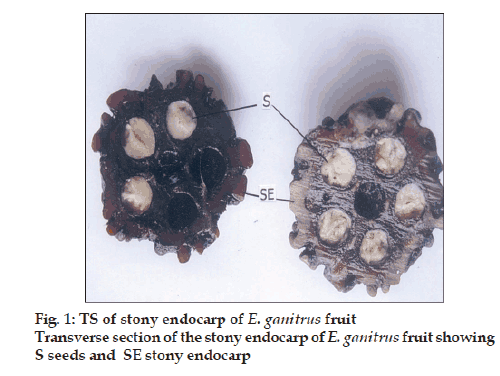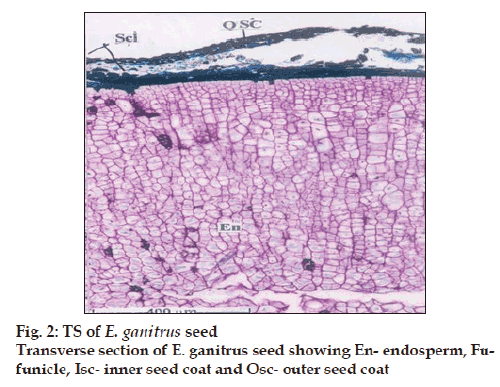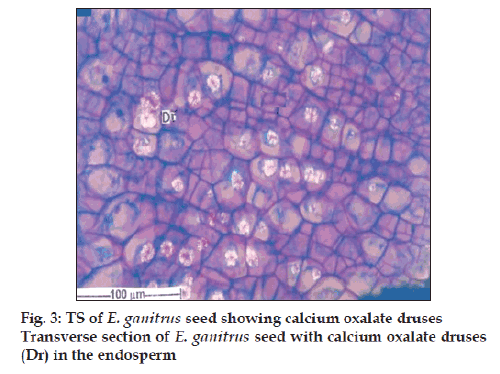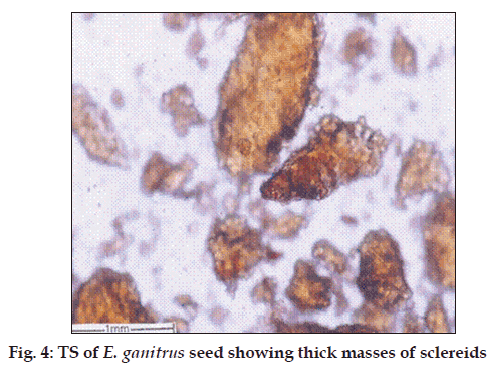- *Corresponding Author:
- B. Singh
Pharmacognosy and Phytochemistry Laboratory, Department of Pharmaceutical Sciences, Guru Nanak Dev University, Amritsar-143 005, India
E-mail: balbir_gndu@yahoo.com
| Date of Submission | 7 July 2009 |
| Date of Revision | 23 November 2009 |
| Date of Acceptance | 24 March 2010 |
| Indian J Pharm Sci 2010, 72 (2): 261-265 |
Abstract
Rudrakasha is the dried bead obtained from the ripe fruit of Elaeocarpus ganitrus Roxb. (Family: Elaeocarpaceae). Microscopic studies revealed the presence of a hard endocarp with lignified isodiametric sclereids, seeds with membranous seed coat, which enclosed a dense cellular endosperm comprising of calcium oxalate druses. Physicochemical parameters showed that total ash was 1.36 times and 1.56 times more than the acid insoluble ash and water-soluble ash, respectively. Further, ethanol had a maximum extractable value of 2.4% and moisture content was found to be 9.7%. Different extracts, petroleum ether, chloroform, ethanol and water were prepared. Chemically the extracts showed the presence of phytosterols, fats, alkaloids, flavonoids, carbohydrates, proteins and tannins. The extracts were evaluated for antifungal activity on different fungal strains. Chlorofom and ethanol extracts have high antifungal activity against Candida albicans. Whereas, chloroform, ethanol and water extracts showed moderate inhibition against Aspergillus niger.
Keywords
Rudrakasha, Elaeocarpus ganitrus, antifungal activity, Candida albicans, Aspergillus niger
Elaeocarpus ganitrus Roxb. (Syn. E. sphaericus Gaertn; family Elaeocarpaceae), is popular for its attractive fruit stones. Its beads are covered by an outer shell of blue color on fully ripening, hence also called blueberry beads [1]. It finds a prominent place in Hindu religion and Ayurveda, the ancient Indian system of medicine. In Hindi it is known as Rudraksha [2]. Rudrakasha fruits are thermogenic, sedative and are useful in cough, bronchitis, neuralgia, cephalagia, anorexia, migraine, manic conditions and other brain disorders [3]. The flesh or pulp of drupe is given in epilepsy, diseases of head and in mental illness [4]. Besides it is reported to exhibit multifarious pharmacological activities that include antiinflammatory [5], analgesic [6], sedative [6], antidepressant [7], antiasthmatic [8], hypoglycemic [4], antihypertensive [9-11], smooth muscle relaxant [12], hydrocholeretic [12], antiulcerogenic [7] and anticonvulsant [13]. A detailed study on pharmacognostic standards of Rudraksha is lacking. In ancient Indian medicine, the fruits were employed to ward off evil spirits and omens [14] which can be considered to be at least partly manifestations of microbial infection. In addition, the Rudrakasha extracts also known to exhibit very high antimicrobial activity [15]. Therefore, it was decided to evaluate the drug (beads) for various pharmacognostic parameters and beads extracts for antifungal activity against different fungal strains.
Dried fruits (beads) of Elaeocarpus ganitrus were procured from a cultivated source, Hind Herb Store, Saharanpur, Uttar Pradesh, India, in the month of September 2007. Identity of dried fruit was confi rmed through Plant Anatomy Research Centre, Medicinal Plant Research Unit, Chennai. Voucher specimen no. PARC/2008/164 has been deposited in the herbarium of the same institute. Coarsely powdered dried fruits were successively extracted with petroleum ether, chloroform and ethanol for 48 h each using Soxhlet apparatus and finally boiled with distilled water for 6 h. The extracts were filtered, concentrated in vacuo and dried in an oven at 40-50º. After removal of solvents under vacuo from various extracts, the percentage of various extractives obtained was: petroleum ether extract (PE) 1.655, chloroform extract (CE) 0.458, ethanol extract (EE) l.538 and water extract (WE) 1.013. Other physicochemical parameters [16,17] showed total ash of 1.5%, acid insoluble ash 1.1%, water-soluble ash 0.96%, pet ether soluble extractive 1.3%, chloroform soluble extractive 0.5%, ethanol soluble extractive 2.4%, water soluble extractive 1.8% and loss on drying 9.7%. Phytochemical screening [18-22] gave positive test for phytosterols, fats, alkaloids, flavonoids, carbohydrates, proteins and tannins.
For microscopic studies the paraffin embedded specimens were sectioned with the help of rotary microtome. Thickness of the sections was 10-12 μm. De-waxing of the sections was done by customary procedure [23]. The sections were stained with toluidine blue as per well documented method [24]. Wherever necessary sections were also stained with safranin, fast-green and iodine solution. Powdered material was cleared with chloral hydrate (S. D. Fine Chemicals Ltd., Mumbai, India) and mounted in glycerine (Glaxosmithkline Pharmaceuticals Ltd. Mumbai, India) and stained where ever necessary. The fruit had a hard, stony endocarp or sclerotesta. The surface of the endocarp was black, deeply folded, and hard with ridges and furrows. Mesocarp was not seen in the fruit. The fruit included five or six carpels, each carpel having a single large seed (fig. 1). In sectional view, the seed was elliptical and consisted of a membranous seed coat. The seed coat enclosed a dense cellular endosperm (fig. 2). The seed coat, though membranous, is differentiated into outer darkly staining cell layer and inner vertically oblong compact dark cell layer. They have dense accumulation of tannins. The middle seed coat has two or three layers of circular brachysclereids or stone cells. Their walls are highly lignified. The sclereids have dark cell contents. The endosperm cells are in parallel compact rows. They extend from periphery to the centre; the cells are squarish and thin walled. The cells towards the periphery are smaller and they become gradually larger towards the centre of the seed. The endosperm cells have large calcium oxalate druses or sphaerocrystals. The crystals are either one or two per cell. They are random in distribution (fig. 3). The druses are 10 μm in diameter. The stony endocarp or sclerotesta consists of only sclereids. No other cell types or cell inclusions are evident in the powder (fig. 4). The sclereids may be short or elongated. The short sclereids are isodiametric. The sclereid walls are highly lignifi ed; the cells have wide lumen with brownish content.
In vitro antifungal activity of all the extracts was carried out using the disk-diffusion assay [25] and broth dilution test [26,27]. The disk-diffusion assay was applied to determine the growth inhibition of fungi by extracts to be tested. Overnight fungal cultures (100 μl) were spread onto SDA. The extracts were applied to 8 mm disks (Whatman paper No.1). After 48 h of incubation at 25o, the diameter of growth inhibition zones was measured. MIC of all extractives was determined by broth dilution test which was performed in test tubes. The conidial suspension, which gave the fi nal concentration of 1×105 CFU/ml, was prepared. A growth control tube and a sterility control tube were used in each test. After 24-72 h incu bation at 25°, the MIC was determined visually as the lowest concentration that inhibits growth, evidenced by the absence of turbidity on the fungal strains, Asperagillus niger (MTCC-281), Candidum geotrichum (MTCC-3993), Candida albicans (MTCC- 227), C. glabrata (MTCC-1637) and C. tropicalis (MTCC-230) using ketoconazole as the positive control. Minimum inhibitory concentration (MIC) is the concentration required to inhibit fungal cell proliferation by 50% after exposure of cells to test compounds. Inhibitory concentration in terms of MIC (mg/ml) was determined using turbidimetry method (Table 1). Maximum inhibition was observed for CE (MIC 1.5 mg/ml), followed by EE (MIC 4.0 mg/ml) on C. albicans. In the case of C. tropicallis maximum inhibition of MIC 5.0 mg/ml was observed for CE, whereas, no inhibition was observed for EE and WE. Maximum inhibition of MIC 3.0 mg/ml on A. niger was observed for CE and EE, which is followed by WE (MIC 5.0 mg/ml). It is also pertinent to mention here that various plant extracts showed no sign of inhibition on C. glabrata and G. candidum even at higher concentration.
| Strains | Extractives | Dilutions (mg/ml) | ||||||||
|---|---|---|---|---|---|---|---|---|---|---|
| 0.125 | 0.5 | 1.0 | 1.5 | 2.0 | 3.0 | 4.0 | 5.0 | Ketocon azole | ||
| C. albicans | CE | +++ | ++ | + | - | - | - | - | - | - |
| MTCC 3017 | EE | +++ | +++ | +++ | +++ | ++ | + | - | - | - |
| WE | +++ | +++ | +++ | +++ | +++ | +++ | +++ | +++ | - | |
| C. tropicallis | CE | +++ | +++ | +++ | +++ | +++ | ++ | + | - | - |
| MTCC 230 | EE | +++ | +++ | +++ | +++ | +++ | +++ | +++ | +++ | - |
| WE | +++ | +++ | +++ | +++ | +++ | +++ | +++ | +++ | - | |
| C. glabrata | CE | +++ | +++ | +++ | +++ | +++ | +++ | +++ | +++ | - |
| MTCC 1637 | EE | +++ | +++ | +++ | +++ | +++ | +++ | +++ | +++ | - |
| WE | +++ | +++ | +++ | +++ | +++ | +++ | +++ | +++ | - | |
| C. geotricum | CE | +++ | +++ | +++ | +++ | +++ | +++ | +++ | +++ | - |
| MTCC 3993 | EE | +++ | +++ | +++ | +++ | +++ | +++ | +++ | +++ | - |
| WE | +++ | +++ | +++ | +++ | +++ | +++ | +++ | +++ | - | |
| A. niger | CE | +++ | +++ | ++ | ++ | + | - | - | - | - |
| MTCC 1344 | EE | +++ | +++ | ++ | ++ | + | - | - | - | - |
| WE | +++ | +++ | +++ | ++ | ++ | + | + | - | - | |
Table 1: In Vitro activity of E. Ganitrus on various fungal strains
In conclusion, microscopic studies revealed the presence of a hard stony endocarp and elliptical seed with a membranous seed coat, which enclosed a dense cellular endosperm and had a dense layer of circular brachysclereids. Endosperm had a large calcium oxalate druses or spaheorocrystal. Powder microscopy revealed that stony endocarp had only isodiametric sclereids, with lignified walls. Physicochemical parameters viz total ash, acid insoluble ash; water soluble ash, extractive values and loss on drying were performed. Total ash was about 1.36 times more than the acid insoluble ash indicating the presence of good acid soluble inorganic matter in E. ganitrus. The water soluble ash was 1.56 times less than the total ash. Out of all the solvents used, ethanol had a maximum extractable value of 2.4%, whereas chloroform had a minimum value of 0.5%. Moisture content was found to be 9.7%. In phytochemical investigations, PE showed the presence of phytosterols along with fats and fixed oils. CE had phytosterols. EE gave the tests for alkaloids, flavonoids, carbohydrates, proteins and tannins. WE showed the presence of proteins, tannins and carbohydrates. All the extracts (PE, CE, EE and WE) were evaluated for the antifungal activity on different fungal strains. The maximum inhibition (MIC 1.5 mg/ ml) was observed for CE against C. albicans. The CE and EE showed maximum inhibitory potential (MIC 3.0 mg/ml) on A. niger. In conclusion the CE and EE were found to be more active antifungals. The activity guided fractionation of active extracts may be taken up for further development.
References
- Pandey G editor. Dravyaguna Vijnana (MateriaMedica- vegetable drugs). Krishna Das Ayurvedic series 48. Part III. Varanasi: Chowkhamba Krishanadas Academy; 2004. p. 261-2.
- Asolkar LV, Kakkar KK, Chakre OJ. editors. Second supplement to glossary of Indian medicinal plant with active principles. Vol. 1, suppl 2. New Delhi; Publication and Information Directorate, CSIR; 1992. p. 177.
- Available from: http://www.devshoppe.com/RudrakshaTherapy.html. [cited in 2009].
- Satyavati GV, Raina MK, Sharma, M, editors. Medicinal Plants of India. New Delhi: Indian Council of Medical Research; 1976. p. 370-1.
- Singh RK, Pandey BL. Anti-inflammatory activity of Elaeocarpus sphaericus fruit extract in rats. J Med Arom Plant Sci 1999;21:1030-2.
- Katavic PL, Venables DA, Rali T, Carroll AR. Indolizidine alkaloids with delta-opioid receptor binding affinity from the leaves of Elaeocarpus fuscoides. J Nat Prod 2007;69:1295-9.
- Singh RK, Acharya SB, Bhattacharya SK. Pharmacological activity of Elaeocarpus sphaericus. Phytother Res 2000;14:36-9.
- Singh RK, Bhattacharya SK, Acharya, SB. Studies on extracts of Elaeocarpus sphaericus fruits on in vitro rat mast cells. Phytomed2000;7:205-7.
- Sarkar PK, Sengupta SS, Bhattacharya SS. Effect of Elaeocarpus ganitrus Roxb. seeds on blood pressure. Indian J Pharma 1972;4:128-35.
- Sarkar PK, Sengupta SS. Studies with ethylacetate extract of Elaeocarpus ganitrus seeds on mammalian heart-intact and isolated preparations. Indian J Pharm 1972;4:129-37.
- Sarkar PK, Sengupta SS, Bhattacharya SS. Further observations with Elaeocarpus ganitrus on normal and hypodynamic hearts. Indian JPharm 1973;5:252-8.
- Bhattacharya SK, Debnath PK, Pandey VB, Sanyal AK. Pharmacological investigations on Elaeocarpus ganitrus. PlantaMedica 1975;28:174-7.
- Dasgupta A, Agarwal, SS, Basu DK. Anticonvulsant activity of the mixed fatty acids of Elaeocarpus ganitrus roxb. (rudraksh). Indian J Physiol Pharmacol 1984;28:245-6.
- Acharya RS, editors. In: Shiv Purana. Vol 1. Barely: Sanskrit Institute; 1976. p. 170.
- Singh RK, Nath G. Antimicrobial activity of Elaeocarpus sphaericus. Phytother Res 1999;13:448-50.
- The Indian Pharmacopoeia, Vol. 2. New Delhi: Controller of Publications; 1996. p. A48-99.
- WHO guidelines. Quality control methods for medicinal plant materials. Geneva: 1998. p. 30-1.
- Evans WC, editor. Alkaloids. Trease and Evans Pharmacognosy. 14th ed. Noida: Gopsons Papers Limited; 1996. p. 340.
- Farnsworth NR. Biological and phytochemical screening of plants. J Pharm Sci 1966;55:225-86.
- Evans WC, editor. Carbohydrates. Trease and Evans Pharmacognosy, 14th ed. Noida: Gopsons Papers Limited; 1996. p. 191.
- Evans WC, editor. Phenols and phenolic glycosides. Trease and Evans Pharmacognosy, 14th ed. Noida: Gopsons Papers Limited; 1996. p. 218.
- Khandelwal KR. editor. Preliminary Phytochemical Screening. Practical Pharmacognosy, 12th ed. Pune: NiralliParkashan; 2004. p. 149-56.
- Johansen DA. Plant Microtechnique. 1st ed. New York: McGraw-Hill; 1940. p. 523.
- O’Brien TP, Feder N, Mccull ME. Polychromatic Staining of Plant cell walls by toluidine blue O. Protoplasma 1965;59:368-73.
- Patel RP, Trivedi BM. The in vitro antibacterial activity of somemedicinal oils. Indian J Med Res 1962;50:211-22.
- Newton SM, Lau C, Gurcha, S, Besra, GS, Wright CW. The evaluation of forty three plant species for in vitro antimycobacterial activities; isolation of active constituents from Psoralea coryfolia and Sanguinaria canadenes. J Ethnopharmacol 2002;79:57-67.
- Collier HOJ, Potter MD, Taylor EP Antifungal activities of bisisoquinolinium and bisquinolinium salts. Br J Pharmacol 1955;10:343-9.
- Hamza OJM. Antifungal activity of some Tanzanian plants usedtraditionally for treatment of fungal infections. J Ethnopharmacol 2006;108:124-32.



